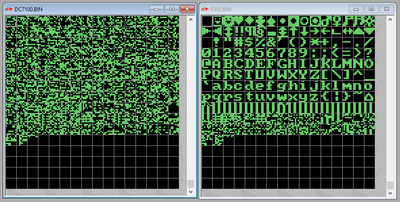Hi there. My apologies for intrusion into this topic. I don't know how to exactly fix things, but I have ideas to try out.
Please don't be upset if they don't work. They're just ideas.
a) You can try loading QEMM. It has a Stealth mode which moves Video BIOS and other things around in memory. That maybe fixes memory corruptions/conflicts.
b) Try out a different code page. Normally, German DOS uses CP850 and loads EGA.SYS, ANSI.SYS etc.
In short, it tinkers with EGA/VGA fonts. By REMing them out, CP437 get loaded (US default, code page traditionally stored in ROM).
c) Try another version of DOS which uses a custom VGA font. Like Japanese MS-DOS (DOS/V 6.20).
You can use US and JP command to switch between two code pages (CP437 and Japan/Kanji).
Your program may or may not work in Japanese mode. It's just a try.
d) Use Virtual PC 2007 and MS-DOS 6.22 (VM), if you're running XP (or to a strech Vista/7) on that laptop.
It's not worse than command prompt on Windows. Virtual PC has its own VGA graphics (S3 Trio32/64), so it's unaffected.
e) Use MS-DOS Player, it's a command line tool that lets MS-DOS programs run.
https://www.zophar.net/pc/ms-dos-player.html
f) try to play with MODE MONO and MODE CO40 and MODE CO80 on DOS.
g) Try out custom VGA fonts. They have *.FNT extension, I believe. They replace the standard font in RAM.
Anyway, again, these are just ideas. Wild ideas, so to say.
Ideally, the source of the problem is being found, so that a proper solution can be made out.
Good luck! 😀 🤞
Edit: I have a wild guess were the problem might come from - the BIOS splash screen / boot screen.
Some later PC BIOSes used custom text glyphs to draw GUI elements in text-mode (like a Windows-like mouse cursor or a hour glass on DOS) or for displaying a logo.
Like that Energy Star logo. It usually is assembled out of a dozen of individual text characters that are being custom/modified.
And maybe the standard VGA font wasn't being properly restored after the POST screen was shown for whatever reason.
Anyway, it's just a wild guess. The chance is low that this is really the case. It's just a possibility that crossed my mind. 😅
"Time, it seems, doesn't flow. For some it's fast, for some it's slow.
In what to one race is no time at all, another race can rise and fall..." - The Minstrel
//My video channel//






